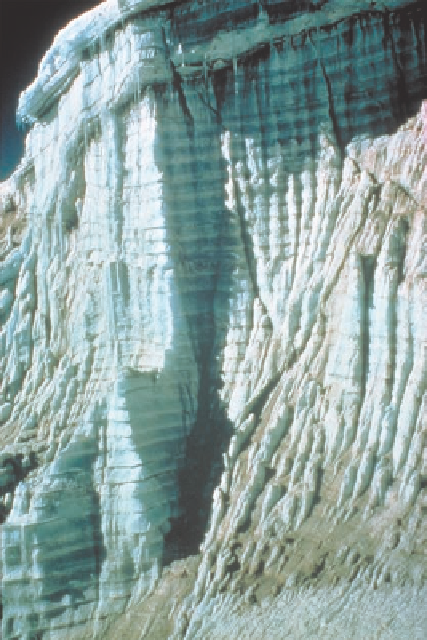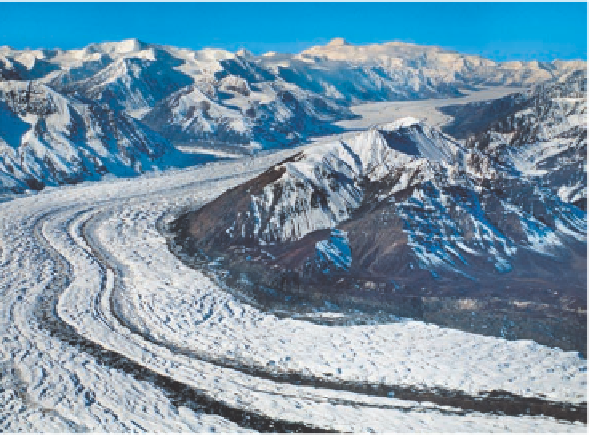Geoscience Reference
In-Depth Information
Development of a Glacier
A
glacier
is a slowly moving mass of dense ice (Figure 17.1)
formed by the gradual thickening, compaction, and recrystal-
lization of snow and water over time. For these processes to
take place, glaciers develop in regions where heavy snows fall
in the winter and then fail to melt completely during the sub-
sequent summer. For such a scenario to occur, summers are
usually short, with temperatures sufficiently cool that some
snow remains when the next winter arrives. If the amount of
remaining snow gradually grows and thickens with time, it
will slowly transform to a river of flowing ice that shapes the
landscape.
The Metamorphosis of
Snow to Glacial Ice
How is it possible that snow can be transformed into a flow-
ing glacier? Recall the discussion in Chapter 11 about cer-
tain kinds of metamorphic rocks and how they form because
of high pressure due to compaction from overlying sedi-
ments. The process of snow transformation to glacial ice is
very similar. The first thing to remember is that the meta-
morphosis of snow to flowing ice takes a great deal of time,
often hundreds or even thousands of years. Over this course
of time, snow accumulates annually in a way that slowly in-
creases the overall thickness of the snow mass. These an-
nual accumulations can be seen as distinct layers that are
Figure 17.2 Annual snow layers in a glacier.
A key factor
in glacial formation is summer temperatures. If snow from the
preceding winter fails to melt, it can then accumulate in layers
like these in the Quelccaya ice cap in Peru. The average thick-
ness of these layers is about .75 m (2.5 ft). Note the similarity
between these layers and those found in nondeformed sedimen-
tary rocks.
somewhat similar to sedimentary deposits (Figure 17.2),
which is why some glaciologists think of glacial ice as being
a form of sedimentary rock.
It is useful to think of snow as being the raw material
for a developing glacier. When snow first falls, it is approxi-
mately 80% air. This snow is then progressively buried by
additional layers of snow in subsequent years. As a result,
it gradually compacts and recrystallizes due to the weight
of snow above it. In addition, some of the snow might melt
and refreeze. Water may percolate downward into the com-
pacting snow from summertime rain that falls on the surface
of the snow pack and from the limited snowmelt that takes
place within it. As a result of these combined processes, the
lowest deposits of snow are slowly transformed into a com-
pact, granular substance called
irn
(Figure 17.3). Firn is
somewhat similar to the crunchy substance that forms within
the top of snow after it melts a bit during the daytime and
Figure 17.1 A typical glacier.
Valley glaciers like this one in
Alaska's Wrangell-St. Elias National Park are rivers of moving ice
that slowly flow down the mountains from their snowy source
areas.
Glacier
A slow-moving mass of dense ice that flows under its
own weight.
Firn
The compact, granular substance that is the transition
stage between snow and glacial ice.





